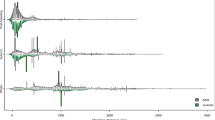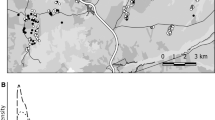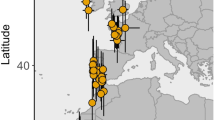Abstract
Migration is a critical period in a bird’s life that can affect the fitness of individuals. Intra-population migratory patterns and the way different sex and/or age classes within a population differ in timing and/or distance of migration are not completely understood. The present study aims to observe inter- and intra-population migratory patterns in the western population of Lesser Black-backed Gulls (Larus fuscus spp.), shedding light on age-related differences of temporal patterns of occurrence in the Portuguese coastal areas during migration and winter. One thousand seven hundred and fifty-four colour ring records were analysed matching a 30-year period of observations on the Portuguese coast between 1975 and 2005. During migration, the graellsii population represents 90% of the migratory flow of L. fuscus through Portugal with the intermedius accounting for 9% and the fuscus population, being vestigial in this period, accounting for 1%. Nevertheless, interesting significant differences were observed between the age classes of the three populations during this period, the graellsii population having a large number of first winters (40% of the migratory contingent of this population) followed by immatures and adults whilst in the intermedius and fuscus populations, the largest age class is the adults. During winter, no inter-population differences were found. When comparing migration and winter periods, intra-population differences were found in the graellsii and fuscus populations regarding distribution and age classes. These results indicate different migratory routes amongst different populations suggesting a leapfrog migration in L. fuscus and also a differential age-related migration pattern that might result from first winters migrating further south in search of a wintering place since adults heavily occupy the closest wintering quarters in their attempt to arrive earlier at their breeding ground.


Similar content being viewed by others
References
Alerstam T (1998) The development of bird migration theory. J Avian Biol 29:343–369. doi:10.2307/3677155
Alerstam T, Hedenstrom A (1998) The development of bird migration theory. J Avian Biol 29:343–455. doi:10.2307/3677155
Bell CP (2005) Inter- and intrapopulation migration patterns. In: Greenberg R, Marra PP (eds) Birds of two worlds; the ecology and evolution of migration. Johns Hopkins U. Press, Portland, pp 41–52
BirdLife International (2004) Birds in Europe: populations estimates, trends and conservation status. BirdLife International, Cambridge
Boland JM (1990) Leapfrog migration in north American shorebirds: intra- and interspecific examples. Condor 92:284–290. doi:10.2307/1368226
Cramp S, Simmons K (eds) (1982) The birds of the western Palearctic, vol III. Oxford University Press, New York
Cristol DA, Baker MB, Carbone C (1999) Differential migration revisited: latitudinal segregation by age and sex class. In: Jr VN, Ketterson ED, Thompson CF (eds) Current ornithology volume 15. Kluwer, New York
Estabrook CB, Estabrook GF (1989) Actus: a solution to the problem of analysing sparse contingency tables. Hist Methods 22:5–8
Estabrook GF, Almada V, Almada FJ, Robalo JI (2002) Analysis of conditional contingency using Actus2 with examples from studies of animal behavior. Acta Ethol 4:73–80. doi:10.1007/s102110100050
Galván I, Marchamalo J, Bakken V, Traverso JM (2003) The origin of Lesser Black-backed Gulls Larus fuscus wintering in central Iberia. Ringing Migr 21:209–214
Gauthreaux JSA (1982) The ecology and evolution of avian migration systems. In: Farner DS, King JR, Parker KC (eds) Avian biology. Academic, New York, pp 93–163
Greenberg R, Marra PP (2005) Birds of two worlds; the ecology and evolution of migration. Johns Hopkins U. Press, Portland
Ketterson ED, Nolan V (1983) The evolution of differential bird migration. In: Power DM (ed) Current ornithology, vol 1. Kluwer, New York
Kilpi M, Saurola P (1984) Migration and wintering strategies of juveniles and adults Larus marinus, L. argentatus and L. fuscus from Finland. Ornis Fenn 61:1–9
Liebers D, Helbig AJ (2002) Phylogeography and colonization history of Lesser Black-backed Gulls (Larus fuscus) as revealed by mtDNA sequences. J Evol Biol 15:1021–1033. doi:10.1046/j.1420-9101.2002.00454.x
Manly BFJ (1997) Randomization, bootstrap and Monte Carlo methods in biology. Chapman and Hall, London
Pütz K, Helbig AJ, Pedersen KT, Rahbek C, Saurola P, Juvaste R (2008) From fledging to breeding: long-term satellite tracking of the migratory behaviour of a Lesser Black-backed Gull Larus fuscus intermedius. Ringing Migr 24:7–10
Rock P (2002) Lesser Black-backed Gull. In: Wernham CV, Toms MP, Marchant JH, Clark JA, Siriwardena GM, Baillie SR (eds) The migration atlas: movements of the birds of Britain and Ireland. Poyser, London, pp 365–368
Schmaljohann H, Liechti F, Bruderer B (2008) First records of Lesser Black-backed Gulls Larus fuscus crossing the Sahara non-stop. J Avian Biol 39:233–237. doi:10.1111/j.2007.0908-8857.04174.x
Ueta M, Higuchi H (2002) Difference in migration pattern between adult and immature birds using satellites. Auk 119:832–835. doi:10.1642/0004-8038(2002)119[0832:DIMPBA]2.0.CO;2
Acknowledgment
We wish to thank all the ring readers in Portugal for reporting their readings and to Central Nacional de Anilhagem for access to the database. PAMM was supported by grant SFRH/BPD/34846/2007 and PEJ by grant SFRH/BPD/22669/2005 both from “Fundação para a Ciência e a Tecnologia.”
Author information
Authors and Affiliations
Corresponding author
Additional information
Communicated by P. Heeb
Rights and permissions
About this article
Cite this article
Marques, P.A.M., Costa, A.M., Rock, P. et al. Age-related migration patterns in Larus fuscus spp.. acta ethol 12, 87–92 (2009). https://doi.org/10.1007/s10211-009-0060-y
Received:
Revised:
Accepted:
Published:
Issue Date:
DOI: https://doi.org/10.1007/s10211-009-0060-y




